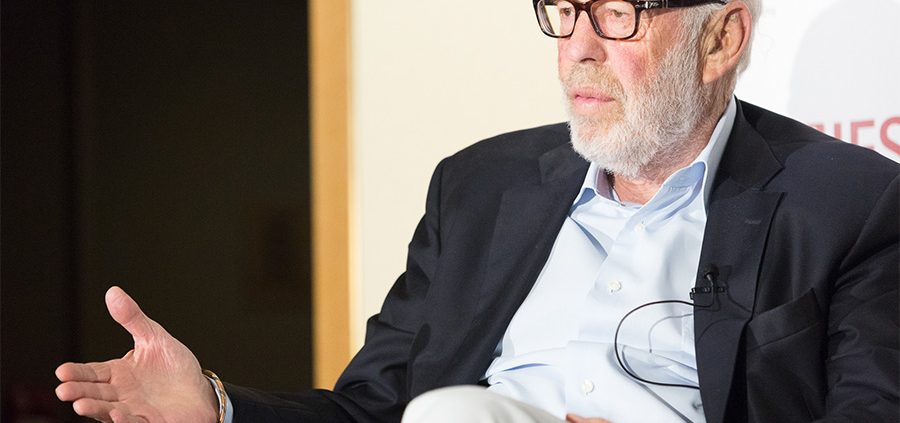From Soy Beans to STEM with James Simons
Investor and philanthropist talks at New York campus about business and investing in teachers and scientific research
New York, October 30, 2017. – “Soybeans. Buy soybeans.”
This was the advice the newly married James Simons received upon researching profitable investment ideas for a $5,000 wedding gift he and his wife had received in the early ‘60s. He bought the beans and then sold them for a modest profit.
What Simons didn’t realize at the time was that the soybeans were his introduction to the world of futures and commodities trading. This led him to develop a highly profitable pattern recognition formula for quantitative trading and to found the multi-billion-dollar investment management firm Renaissance Technologies in 1982.
Simons spoke with Prof. Bill Baker on the New York campus about his start in business, his attitudes toward hiring and administrative tasks, and his extensive philanthropic efforts to support high school teachers and scientific research.
Hiring the Best and Delegating the Rest
Simons said he realized early in his business career that hiring the right people was key. In 1968, Simons was charged with building and directing the new math department at Stony Brook University in New York. “I hired the best and let them do their thing,” he said.
“I love recruiting. I love finding good people,” he added.
Whether at Stony Brook, or Renaissance Technologies, or the Simons Foundation, which he and his wife, Dr. Marilyn Simons, founded together in 1994, Simons has always believed that “management needs to hire the greatest people possible and give them a lot of authority and then notmicromanage.”
But while he loved and excelled in some aspects of business, others weren’t his forte. “Administration, never liked it,” Simons said. “It just wasn’t my thing. Instead, I did my best to identify the right person and have that person handle the administrative tasks.”
On Science, Technology, Engineering and Mathematics (STEM) Education
His belief in people has made its way into his foundation’s philanthropic efforts in STEM education. In 2004, through the Simons Foundation, he and his wife created Math for America to promote the recruitment, retention, training and continued support of high-quality math teachers in New York City. Currently, 10 percent of all math and science teachers in the city are a part of the program.
“Our kids in this country are not trained well in STEM; we are really behind in the U.S.,” Simons stated. As a result of poor math and science programs in high school, “our kids aren’t going into engineering and science in college. That says to me we are failing kids in high school.”
He recalled that when he was a child, teachers could make a decent living but today, “teaching in America is no longer a well-paying, venerated job.”
This is largely why Math for America was created. Simons believes that by identifying, training and supporting high-quality STEM teachers, high schools in the U.S. will improve. In fact, he hopes Congress will create a national program similar to Math for America.
“I’ve spoken to congressmen and congresswomen across the country. If we can get about 20% of the STEM teachers in the U.S. into a program like Math for America, it would cost roughly $2 billion – that’s barely a drop in the bucket compared to the grand scheme of things.”
Funding the Basics
The Simons Foundation also invests nearly $400 million each year to support researchers investigating the basic natural phenomena of the world. “Basic science is what I love,” he said.
“At the Simons Foundation, we tend to fund things that the NIH wouldn’t necessarily fund in the life sciences,” he explained. For example, while the National Institutes of Health (NIH) funds a lot of cancer research, it likely wouldn’t fund an expansive research project into the origins of life, “and that is exactly the kind of research we want to support, among a variety of others. Don’t we all want to know how we got here, where we all come from?” Simons asked.
Recently, the Simons Foundation launched another major endeavor that current institutions could not undertake: the Flatiron Institute. The Flatiron Institute is an in-house research division at the Simons Foundation, wherein computational scientists are supported in tackling thorny, long-term scientific questions, free of the need to constantly reapply for grants or to publish.
Fundamentals, in science or business, are important. And there is beauty in the often surprising simplicity of fundamental truths. “As a mathematician, one of the best compliments you can get is ‘oh, that’s beautiful.’ I’ve always been led by that,” Simons explained. “What would be the most elegant solution to this problem? I’ve approached business in this same way.”



